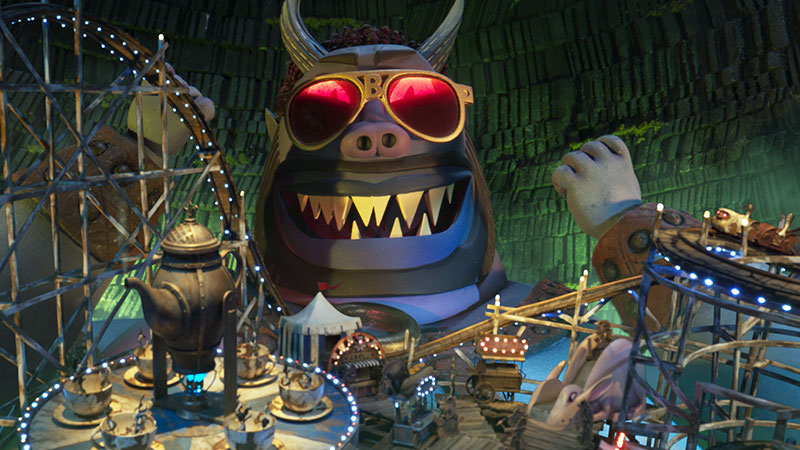VFX Supervisor Aladino Debert talks about creating an entirely digital train chase, faeries’ wings in flight and bringing terror to life in a photoreal monster for Season 2 of Carnival Row.

For the second and final season of Amazon Prime Video's TV series Carnival Row, the team at Digital Domain helped get the action underway by creating an entire train chase sequence in episode one, designing, building and lighting the entire CG landscape. Their work throughout the rest of the series included closely studying flight and motion to create faeries’ wings, and creating a terrifying, photorealistic monster called Sparas from the ground up.
In the series' story, faeries and fauns have fled the wars unsettling their home countries and gathered in the Victorian city of The Burgue. But, discriminated against and forced into service jobs and manual labour, tensions grow between the immigrants and the city’s working class.
Overlaying these universal themes of oppression and social unrest with fantasy gave the artists at Digital Domain a chance to create intriguing creatures, FX and environments for the show.
Real Live Faeries
The faery characters are at the heart of the Carnival Row story, and needed to feel completely real to the audience on many levels – as personalities and heroes as well as mythical creatures. Therefore, Digital Domain heavily researched flight and movement to create the faeries’ wings as realistically as possible, from design through animation.
Digital Media World talked about the project with Digital Domain’s VFX Supervisor Aladino Debert, who told us that getting their faeries to fly convincingly meant addressing two separate topics – the wing design itself, and managing the use of digital doubles.
Faeries’ Wings
“Focussing first on the wings, as we joined the production for Season 2 of the show, the fundamental wing design had already been established to a certain extent,” Aladino said. “While at rest, they appeared as leathery membranes, albeit with a fair amount of mobility, but during flight, they transformed into a blur of movement.”
Primarily drawing inspiration from the rapid fluttering of a hummingbird's wings and certain large insects, the team sought to capture that swift, delicate motion for the faeries in flight, but with the obvious differences in mass. Closely studying the ethereal nature of those birds’ and insects’ wings, blurring at high speeds, added an element of realism and fluidity to the flight sequences.

“The wings proved to be surprisingly difficult to create, causing our CG Supervisor Greg Teegarden and the team to think outside the box. It wasn't the wings themselves, but rather their appearance when flapping at incredibly high speeds,” said Aladino.
“Anyone who has worked in CGI knows what a challenge achieving and art-directing accurate motion blur at high speeds can be. We needed the blur to have a figure 8 shape, which required a fair amount of R&D, and utilizing sub-frame rendering and animation. This was one of those cases when a huge amount of work went into creating something that most people barely notice.”
Digital Doubles vs Stunt Work
Moving on to the second aspect of faery flight, he said, “Since the first season of the show hadn’t employed digital doubles to the extent we planned for Season 2, we had to conduct thorough tests and research to make sure we could convincingly integrate both CG wings and digi-doubles into shots where we mixed live plates with the CG elements. This process was crucial for seamless, realistic results.”
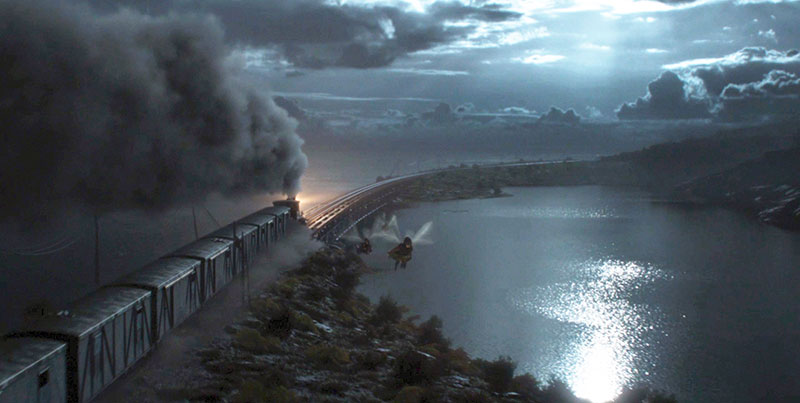
The parallel tasks of incorporating wings onto stunt performers and generating complete digital doubles of the faery characters meant taking extreme care to prevent the look of their digital characters from varying in relation to the practical plates.
“Also wanting to avoid the ‘actor on a wire look’, we collaborated with Todd Shifflett, the VFX Supervisor from the client side, from the outset. Overcoming the challenges of wire stunts, where rotational pivots are at the waist instead of the shoulders, required careful handling,” said Aladino. “Our Animation Supervisor Arda Uysal, Animation Lead Marco La Torre and I worked together on this, ensuring that the bodies felt physically accurate in flight, with pivots at the wing base and incorporating inertia and momentum into their limbs and clothing.”
When the faeries land, for instance, the actors were filmed on wire rigs to create a gentle gliding effect as they descended to the floor. In post-production, CG wings were added after removing the wires and harnesses with meticulous painting and background reconstruction. At the same time, the need to maintain consistency with the plate photography throughout made striking the right balance quite tricky.
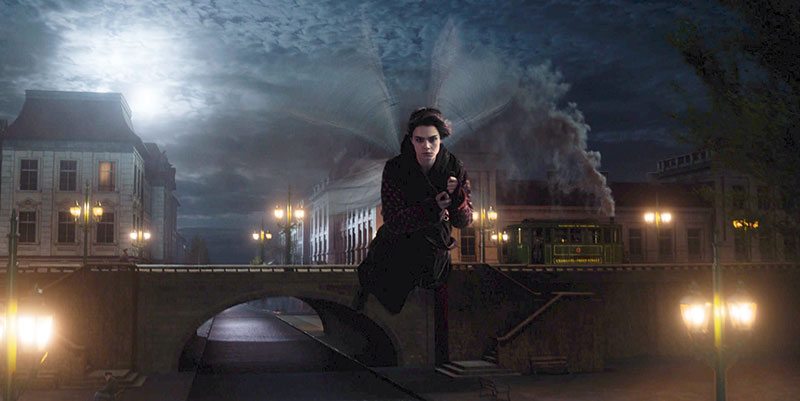
The train heist sequence and the ballroom sequence are each an example of one of the two approaches, and that made the whole process different for each one. “The live-action for the train sequence, which featured the main faery character Vignette, was primarily shot practically, especially for close-ups of the main characters. Thus, we could plan from the beginning how we would integrate our wings onto the stunt rigs,” said Aladino..
“For the ballroom scene, on the other hand, only one of the specific faery characters crashing through the ceiling had been finalized during the plate shoot, and in any case, relying solely on stunts for such risky performances was impractical, especially in the initial shots. We would need a digital solution.
“Beyond any scene-specific benefits, having 100% realistic digital doubles offered flexibility for late creative ideas. For instance, the final shot of the train sequence, where the three faeries fly away from the steaming train towards the camera [see image at the top], was a late addition made during editing, without any existing plate. We were able to confidently create this shot entirely in CG because we were certain that our digitally rendered faeries would withstand close scrutiny and seamlessly blend with the scene.”
Digital Heroes
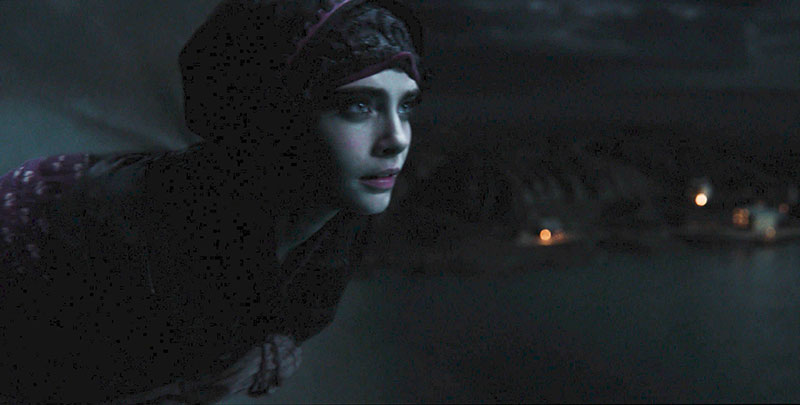
The level of detail Digital Domain strives for when creating ‘hero’ digital doubles is as close to indistinguishable from the real actors as possible, for the reasons mentioned above. This encompasses every aspect of a character, ranging from their clothing and hair to their skin, eyes and more. Nowadays, as Aladino describes here, the process is relatively straightforward.
“Partnering with companies that specialise in this work, we capture high-resolution scans of the actors on set,” he said. “These scans give us detailed topography, or geometry, of the person, accompanied by photographic references capturing their appearance. These references typically consist of multiple polarized passes, incorporating diffuse colour, specular details, and normal passes that help create fine skin detail, for example.
“With this wealth of information and data in hand, our artists then proceed to craft the digital doubles. Once the models are complete, we develop animation rigs for their overall body movements, and in some cases, even for facial performances. As part of the shot creation process, we also simulate the behaviour of clothing and hair on the characters, adding an extra layer of realism to their portrayal.”
Deadly
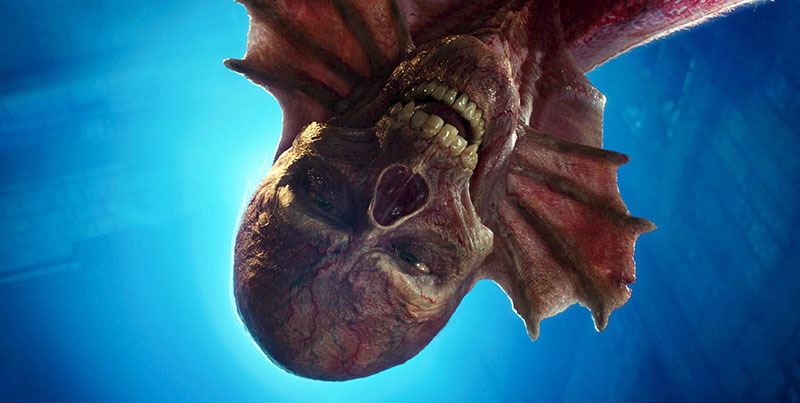
A polar opposite of the faeries, the vicious monster Sparas became an interesting creative puzzle for the team because at pre-production, all they had were a couple of style frames from the production’s art department, without any guidance on its movement, methods of killing, or even how it flew. On the ground, its walk is both awkward and fascinating; in flight, it glides through the air with menacing grace.
Sparas was born from a strange combination of reference. “In the initial stages, I collaborated with Arda Uysal to conduct motion tests,” said Aladino. “Arda recorded himself to serve as reference footage for some of the initial motion tests we conducted. Alongside his footage, we delved into the animal kingdom, particularly observing great apes and flying foxes, to find inspiration for the creature's movements and behaviours.
“This research was pivotal in shaping our understanding and approach to bringing the creature to life on screen. But we also encouraged our animators to have fun and come up with ideas. These tests not only shaped the creature's capabilities from an animation perspective but also worked as creative possibilities for the showrunner and directors in terms of storytelling.”
Sparas from Inside Out
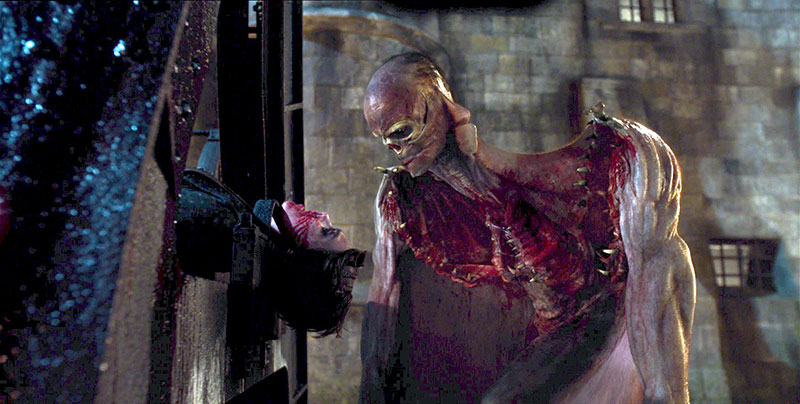
They took on this work even before they had been assigned to work on those specific sequences, believing that by assisting production with these tests, they wouldn’t only contribute to the project but also help secure the opportunity to work on them. Not surprisingly, they were right. As the project progressed, it also became their responsibility to envision the creature's precise manner of killing – and shredding! – its victims from an anatomical standpoint – a crucial aspect of the story.
Since Sparas was conceived as a full CGI construct, they planned from the start to hand animate its entire performance. It represented a lot of work, but also meant there was no need to transfer human motion capture data to the extreme proportions of the animation rig.
When Sparas goes on a killing spree within the inner courtyard of The Burgue prison, meticulous consideration had to be given to the fact that the monster was going to be a CG addition. Aladino said, “The on-set supervisor and director had to account for the fact that all victims would react and be thrown about by an invisible creature to be added in post. As a result, every shot had to be carefully planned and executed keeping this crucial aspect in mind, including all stunt performances.
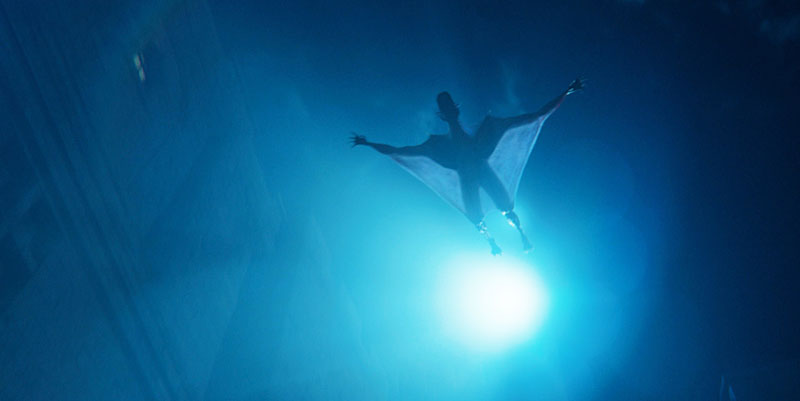
“This is why our initial motion tests played such a critical role in production, as they gave valuable insights into what Sparas was capable of and exactly how it would carry out its gruesome actions, guiding the creative team as they shaped the scenes accordingly.
Captivating Views
Faeries’ wings weren’t the only digital elements in the train sequence. Because the live action was shot on blue screen on a set with minimal props, the Digital Domain team opted for a comprehensive approach and built an entire CG landscape for it, allowing more scope to enhance realism and continuity. “Instead of creating custom areas for each shot, we decided to construct a complete world for the sequence. Even if it seems counter-intuitive, this choice not only simplified our work but also gave the director flexibility. Knowing that we had the ability to rearrange elements if necessary made collaboration smoother and facilitated any adjustments.”
The design of this setting was loosely inspired by the surrounding areas of Prague, where principle photography took place. But the team was able to take advantage of their creative freedom to shape the visuals. Since no other sequences were set in this location, Aladino focussed on creating captivating views rather than strict accuracy.
Exciting Opportunity
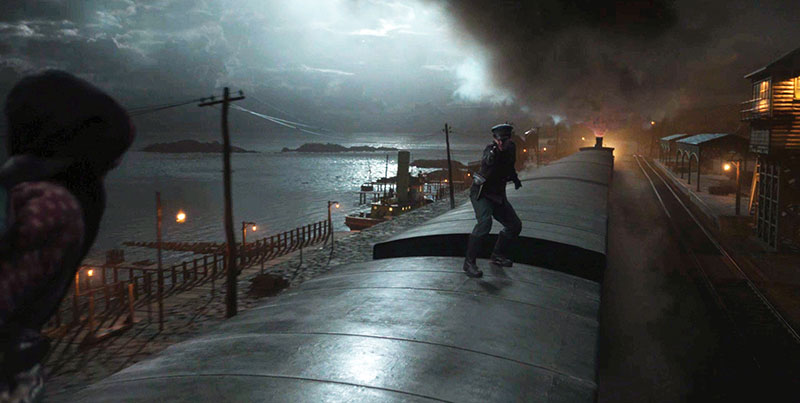
“With no strict references to follow, this was an exciting opportunity,” he said. “Our Environments Lead Chris Watkins, together with Environment Artist Alberto Casu, led the initial strategy by analysing satellite images of the areas surrounding Prague and using that material as a foundation for developing the area.
“Surprisingly, once the landscape was complete, the tasks of plotting out the train journey and creating the POV showing what the camera and faeries would be seeing don't become any more challenging to manage than if we were designing specific areas for each shot or sequence. The advantage lies in having a complete, photoreal setting. Much like photoreal digital doubles, their completeness expands creative freedom – if creative changes arise, we can simply ‘move our camera elsewhere’ within the established locale, confident that it will still look fantastic.
“Of course, this primarily applies to the overall macro scale. As we progressed, we would add specific details to certain areas once we were certain they would be featured in particular shots, such as the iron bridge where Vignette almost loses her life.”
Complex Lighting
The lighting in these sequences is minimal but complicated by combinations of moonlight, cloudy skies and light from multiple gaslights in the streets. Firmly believing that the importance of lighting in achieving believable visual effects cannot be overstated, Aladino explained that Digital Domain’s live-action workflow calls for capturing the lighting from every scene and converting it into a panoramic HDRI. This allows them to closely replicate the on-set lights in post.
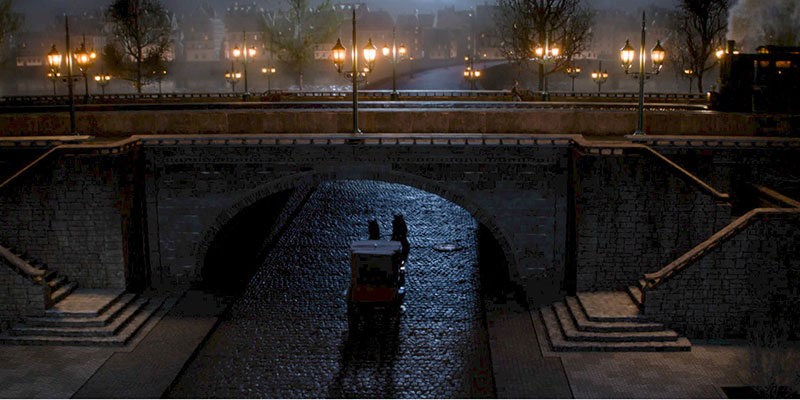
“This has been standard practice for a long time,” he said. “However, when dealing with complete digital environments where the live plates are to be composited, obviously there are new challenges. Despite the excellence of on-set lighting, it rarely matches reality perfectly, although the emergence of LED screens and virtual production sets is rapidly changing this. So we begin with the received HDRI as a starting point, then proceed to design our digital sets, adding lights as necessary, and ultimately combine all elements during compositing for as realistic a result as possible.
“Further to that, during compositing we incorporate lighting passes and colour correct the live plates to better align with the lighting in our digital sets. We can enhance the visual continuity between the practical and digital elements, and create a seamless integration within the final composition.”
Coach and Horses
To illustrate, Aladino described putting together a chase sequence on The Burgue that is entirely CGI, in which a coach and horses pull out of the city and along the road by the sea out to the prison, Bleakness Keep. “This particular case exemplifies how our studio's ability to create expansive worlds allowed us to explore and conceive shots that weren't originally planned,” he said.
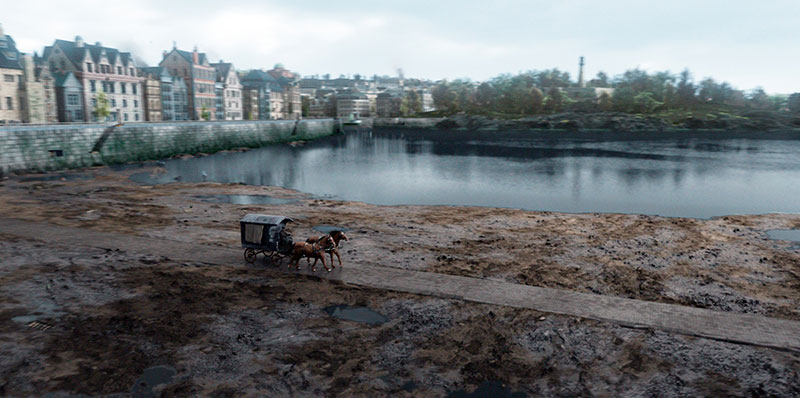
“We had already developed key assets, such as the carriage and horses, and the shot itself involved a combination of 2D matte paintings, 3D city buildings and the prison, and the creation of a new water and land bridge that is revealed during low tide.”
The building process began with animating the basic choreography of the shot, followed by the involvement of various departments. The cloth and hair simulation team (CFX), the water effects team, lighting and ultimately compositing – all played vital roles. Aladino remarkd, “Having confidence in our team and the tools at our disposal allowed a free flow of creative ideas, which is an immensely rewarding aspect of my job.” digitaldomain.com
Words: Adriene Hurst, Editor

















